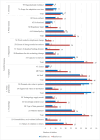The NASSS (Non-Adoption, Abandonment, Scale-Up, Spread and Sustainability) framework use over time: A scoping review
- PMID: 40096260
- PMCID: PMC11913280
- DOI: 10.1371/journal.pdig.0000418
The NASSS (Non-Adoption, Abandonment, Scale-Up, Spread and Sustainability) framework use over time: A scoping review
Abstract
The Non-adoption, Abandonment, Scale-up, Spread, Sustainability (NASSS) framework (2017) was established as an evidence-based, theory-informed tool to predict and evaluate the success of implementing health and care technologies. While the NASSS is gaining popularity, its use has not been systematically described. Literature reviews on the applications of popular implementation frameworks, such as the RE-AIM and the CFIR, have enabled their advancement in implementation science. Similarly, we sought to advance the science of implementation and application of theories, models, and frameworks (TMFs) in research by exploring the application of the NASSS in the five years since its inception. We aim to understand the characteristics of studies that used the NASSS, how it was used, and the lessons learned from its application. We conducted a scoping review following the JBI methodology. On December 20, 2022, we searched the following databases: Ovid MEDLINE, EMBASE, PsychINFO, CINAHL, Scopus, Web of Science, and LISTA. We used typologies and frameworks to characterize evidence to address our aim. This review included 57 studies that were qualitative (n=28), mixed/multi-methods (n=13), case studies (n=6), observational (n=3), experimental (n=3), and other designs (e.g., quality improvement) (n=4). The four most common types of digital applications being implemented were telemedicine/virtual care (n=24), personal health devices (n=10), digital interventions such as internet Cognitive Behavioural Therapies (n=10), and knowledge generation applications (n=9). Studies used the NASSS to inform study design (n=9), data collection (n=35), analysis (n=41), data presentation (n=33), and interpretation (n=39). Most studies applied the NASSS retrospectively to implementation (n=33). The remainder applied the NASSS prospectively (n=15) or concurrently (n=8) with implementation. We also collated reported barriers and enablers to implementation. We found the most reported barriers fell within the Organization and Adopter System domains, and the most frequently reported enablers fell within the Value Proposition domain. Eighteen studies highlighted the NASSS as a valuable and practical resource, particularly for unravelling complexities, comprehending implementation context, understanding contextual relevance in implementing health technology, and recognizing its adaptable nature to cater to researchers' requirements. Most studies used the NASSS retrospectively, which may be attributed to the framework's novelty. However, this finding highlights the need for prospective and concurrent application of the NASSS within the implementation process. In addition, almost all included studies reported multiple domains as barriers and enablers to implementation, indicating that implementation is a highly complex process that requires careful preparation to ensure implementation success. Finally, we identified a need for better reporting when using the NASSS in implementation research to contribute to the collective knowledge in the field.
Copyright: © 2025 Shin et al. This is an open access article distributed under the terms of the Creative Commons Attribution License, which permits unrestricted use, distribution, and reproduction in any medium, provided the original author and source are credited.
Conflict of interest statement
The authors have declared that no competing interests exist.
Figures
Similar articles
-
Identifying barriers and facilitators to successful implementation of computerized clinical decision support systems in hospitals: a NASSS framework-informed scoping review.Implement Sci. 2023 Jul 26;18(1):32. doi: 10.1186/s13012-023-01287-y. Implement Sci. 2023. PMID: 37495997 Free PMC article.
-
Implementation of a Web-Based Program for Advance Care Planning and Evaluation of its Complexity With the Nonadoption, Abandonment, Scale-Up, Spread, And Sustainability (NASSS) Framework: Qualitative Evaluation Study.JMIR Aging. 2025 Mar 4;8:e49507. doi: 10.2196/49507. JMIR Aging. 2025. PMID: 40053753 Free PMC article.
-
Beyond Adoption: A New Framework for Theorizing and Evaluating Nonadoption, Abandonment, and Challenges to the Scale-Up, Spread, and Sustainability of Health and Care Technologies.J Med Internet Res. 2017 Nov 1;19(11):e367. doi: 10.2196/jmir.8775. J Med Internet Res. 2017. PMID: 29092808 Free PMC article.
-
Beyond the black stump: rapid reviews of health research issues affecting regional, rural and remote Australia.Med J Aust. 2020 Dec;213 Suppl 11:S3-S32.e1. doi: 10.5694/mja2.50881. Med J Aust. 2020. PMID: 33314144
-
Global Evidence on the Sustainability of Telemedicine in Outpatient and Primary Care During the First 2 Years of the COVID-19 Pandemic: Scoping Review Using the Nonadoption, Abandonment, Scale-Up, Spread, and Sustainability (NASSS) Framework.Interact J Med Res. 2025 Feb 28;14:e45367. doi: 10.2196/45367. Interact J Med Res. 2025. PMID: 40053716 Free PMC article. Review.
Cited by
-
Advancing the selection of implementation science theories, models, and frameworks: a scoping review and the development of the SELECT-IT meta-framework.Implement Sci. 2025 May 28;20(1):24. doi: 10.1186/s13012-025-01436-5. Implement Sci. 2025. PMID: 40437531 Free PMC article.
-
Building the Infrastructure for Sustainable Digital Mental Health: It Is "Prime Time" for Implementation Science.JMIR Ment Health. 2025 Jul 21;12:e78791. doi: 10.2196/78791. JMIR Ment Health. 2025. PMID: 40690592 Free PMC article.
-
The Baby Friendly Hospital Initiative and Ten Steps to Successful Breastfeeding programs: applying the Non-adoption, Abandonment, Spread, Scale up, Sustainability (NASSS) health technology adoption framework to analyze challenges to hospital implementation in Australia and Indonesia.Int Breastfeed J. 2025 Aug 13;20(1):62. doi: 10.1186/s13006-025-00754-0. Int Breastfeed J. 2025. PMID: 40804413 Free PMC article.
References
-
- Christ C, Schouten MJ, Blankers M, van Schaik DJ, Beekman AT, Wisman MA, et al.. Internet and Computer-Based Cognitive Behavioral Therapy for Anxiety and Depression in Adolescents and Young Adults: Systematic Review and Meta-Analysis. J Med Internet Res. 2020;22(9):e17831. doi: 10.2196/17831 - DOI - PMC - PubMed
LinkOut - more resources
Full Text Sources


